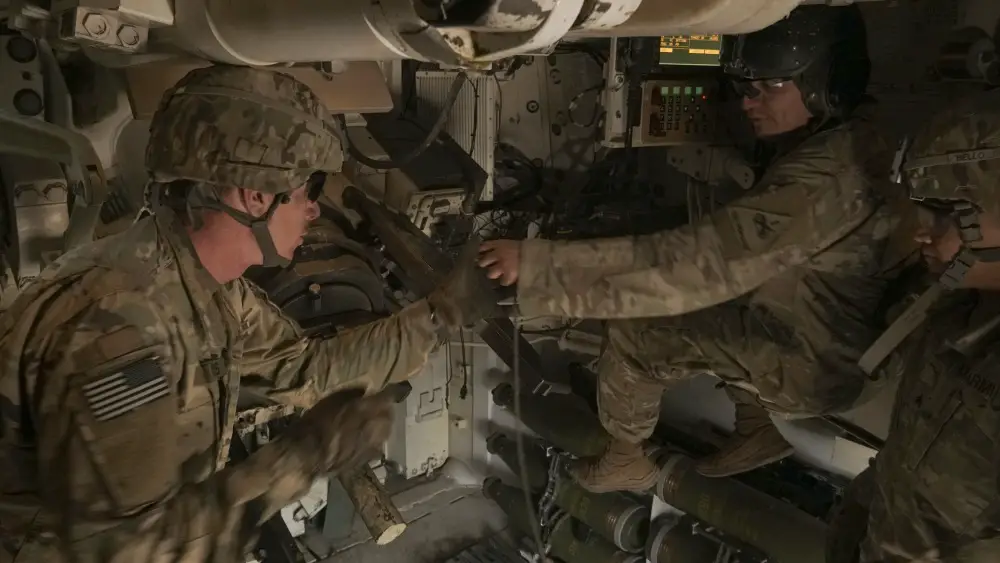DONA ANA, New Mexico. – “The paradox of war is that an enemy will attack any perceived weakness,” said Gen. James Mattis, former U.S. Secretary of Defense, as a part of his National Defense Strategy address in 2018. “So, we in America cannot adopt a single preclusive form of warfare. Rather we must be able to fight across the spectrum of conflict.”
At just below 30,000 feet in the air, and about 30 miles away, a U.S. Air Force F35A Lightning II pilot can spot anti-air threats that would threaten his safety. With it being too dangerous to engage, while continuing to maintain his stealth, the pilot can now call on the U.S. Army’s artillery and missile support to destroy the threat.
This very scenario is what the 1st Armored Division Artillery and the U.S. Air Force trained on in the first week of November in the desert in Dona Ana, New Mexico, during Joint Strike Fighter Integration testing.
“Today we are working with the Air Force and we are testing the ability of the U.S. Army’s field artillery to receive messages from an F35, a 5th generation fighter jet, for possible fire missions,” said Maj. William O’Neil, a Bryn Mawr, Pennsylvania native and the fire support officer for the division. “While we are using canons today, the M109A6 Paladins, the goal is how we integrate a Tomahawk Cruise Missile and other missile units at the division level into Joint Fires.”
It brings the U.S. artillery capabilities into the joint realm, in a much more robust way said O’Neil.
The key to the exercise was transmitting the pilot’s message through different communications networks – some of which weren’t designed to synchronize with different military service communication networks. Rehearsing the routing for the call of fire messages gives the force redundancy and options for cross talk.
“How do we kill targets faster?” said Capt. Charles Humphrey, a Leavenworth, Kansas native, and the exercise director with the Air Combatant Command located at Joint Base Langley-Eustis, Virginia. “The F35 is a very capable aircraft executing against numerous targets. We can use its sensors to identify multiple targets, and we can use the Army to take them out. We can start shaping the battlefield faster, because when we start fighting bigger opponents, we are needing to be able to do that.”
Maj. Scott Portue, a pilot with the 59th Test and Evaluation Squadron, acted as the eye in the sky for the exercise being the first link in the chain with the . The targets he identified were where the artillerymen sent their shells.
“The army is incredibly capable and working together in a true Joint environment, executing a cross-domain kill chain, is not only more efficient but is imperative for the success of American Forces in future conflicts,” Portue said.

Developing this type of joint operations with combining multiple domains, the Air Support Operations Centers can further transition from an air space management capability, which it functioned as in the last 17 years of warfare, into a lethal offensive asset to take out long-range targets, said Humphrey.
The JSF integration exercise tested ways that pilots can stay out of harms way while using other service’s assets efficiently to eliminate aircraft denial weapon systems, of which adversaries may very well have.
“The F-35 has proven to be a valuable asset in a denied environment, however the work that was done has opened the door for many other airborne players to participate and help the fight,” said Maj. Portue. “Utilizing all firepower available in a theater is mandatory for the success of our forces in any theater. Utilizing the strengths of each asset is key for both survivability and lethality.”
With every second counting when calling for fire, the 1st AD units and the Air Force tested about eight networks in which a pilot can do so. Because this type of effort hasn’t been tested beyond a concept, the units are developing the techniques, tactics and procedures for future exercises.
“This is a tactical-level event that helps to further refine our joint integration between the services as we leverage new technologies to get after multi-domain operations,” said Humphrey. “This is one small piece of that as we move forward, which is identifying which capabilities work and how we can actually use those capabilities in peer to peer planning.”
The JSF integration exercise is a simple concept, but the execution on day one was the result of a near immeasurable amount of time and effort.
“Those 10 minutes are the culmination of six months of planning between me, III Corps, U.S. Air Force Air Combat Command, the U.S.A.F 7th Air Support Operations Squadron, and the 59th Test and Evaluation Squadron,” said O’Neil. “There are a lot of players that are a part of 15 organizations and a small army of field service reps for various types of equipment. We verified the proof of concept, not exactly how we wanted it, but overall it was a success.”















